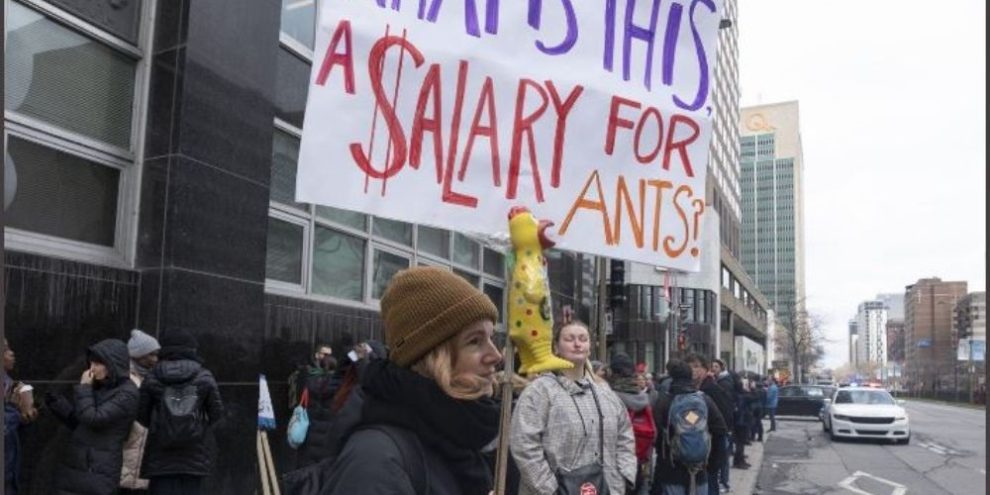
By Cindy Tran and Laura Osman in Ottawa
Federal ministers said Tuesday they were monitoring for blockades of critical roads and infrastructure, as striking federal workers made good on a promise to ramp up their picket efforts by disrupting traffic and limiting access to office buildings in downtown Ottawa.
More than 150,000 federal public servants with the Public Service Alliance of Canada were on strike for the seventh straight day as their union representatives continued to negotiate with the government for a bigger wage increase and more flexibility to work remotely.
Around the National Capital Region, striking workers made their presence felt and heard, circling buildings, chanting through megaphones and blasting music throughout the morning.
Hundreds of public servants marched across the Portage Bridge between Ottawa and Gatineau, Que., where some of the biggest federal buildings are located, holding up traffic for a short period Tuesday morning.
Outside the Prime Minister's Office building and the Treasury Board headquarters a few blocks away, strikers limited entry to just one person every five minutes.
The escalation in the strike activity came after a promise by union president Chris Aylward that picket lines would move to more "strategic locations," including ports of entry where the union predicted the strike would have a greater economic impact.
The spurt of activity had all but disappeared in Ottawa by 2 p.m. with only a trickle of pickets visible outside the Treasury Board building, and nobody left at all near the office building where most of Prime Minister Justin Trudeau's staff work.
Striking public servants only need to head to the picket lines for four hours a day to receive their $75 per day strike pay. The union's strike fund sat at $43 million when the strike began, which may get depleted quickly depending on how many workers show up every day.
Aylward said over the weekend that he wasn't worried about funds running out, but wouldn't elaborate where they union would get the money from.
On Tuesday, three national unions — including the Canadian Labour Congress, Unifor and the Professional Institute of the Public Service of Canada — told The Canadian Press that PSAC had not yet requested donations to bolster its strike fund, and they have not given any.
The Canadian Union of Public Employees also confirmed it had not donated to PSAC.
While it remained unclear how long the strike fund would last, the union promised to up the ante after days of negotiations did not produce an agreement with the government, saying on Monday that it managed to "shut down" ports in Montreal, Vancouver and St. John's.
Federal ministers meeting in Ottawa for a weekly cabinet meeting on Tuesday said they were watching closely.
"On one hand, they have the right to strike and demonstrate," Industry Minister François-Philippe Champagne told reporters.
"On the other hand, we need to make sure that the economy can continue functioning around the country."
Transport Minister Omar Alghabra said he has been in contact with ports and airports to make sure they have contingency plans in place.
"I know Canadians would like us to avoid disruption to travel and supply chains, and our focus is to resolve this at the negotiation table," he said.
Treasury Board President Mona Fortier said Tuesday afternoon that both parties were still at the bargaining table that morning.
In an open letter published Monday, Fortier had identified four main areas of disagreement that remained between the union and the government: wages, teleworking, outsourcing contracts and seniority rules in the event of a layoff.
Fortier would not say if the current wage offer — a nine per cent increase over three years — was the government's final offer.
Instead, she repeated her line that the number was based on a recommendation by the third-party Public Interest Commission, which was appointed to help mediate the contract talks after the union said negotiations hit an impasse last year.
The union has been pushing for a 13.5 per cent increase in pay for its members over the same period of time.
Federal and provincial governments are more aware than ever of how vulnerable and critical major roadways and ports of entry are after last year's "Freedom Convoy," said Ambarish Chandra, an associate professor of economics at the University of Toronto.
Demonstrators took over major roads in downtown Ottawa for three weeks and blockaded several border crossings for days in February 2022 to protest vaccine mandates and the federal government. The protest precipitated the first use of the federal Emergencies Act.
While those events were a far cry from the activities of public servants on strike, federal workers' decision to target points of critical infrastructure could inspire copycat events, said Chandra.
He was one of the experts to testify about protecting the flow of essential goods and services during a public inquiry that assessed the government's decision to use the Emergencies Act in response to the convoy protests.
"The events of last year highlighted how vulnerable we are," he said.
"And it may not be surprising if other groups now seize on that vulnerability to exploit what they now realize is a ... critical shortcoming in infrastructure."
Smaller disruptions at borders and other key locations are likely to be annoying and in some cases costly, he said, but they tend to fade from public memory quickly compared to more-substantial blockades.
Banner image: THE CANADIAN PRESS/Ryan Remiorz
This report by The Canadian Press was first published April 25, 2023.





